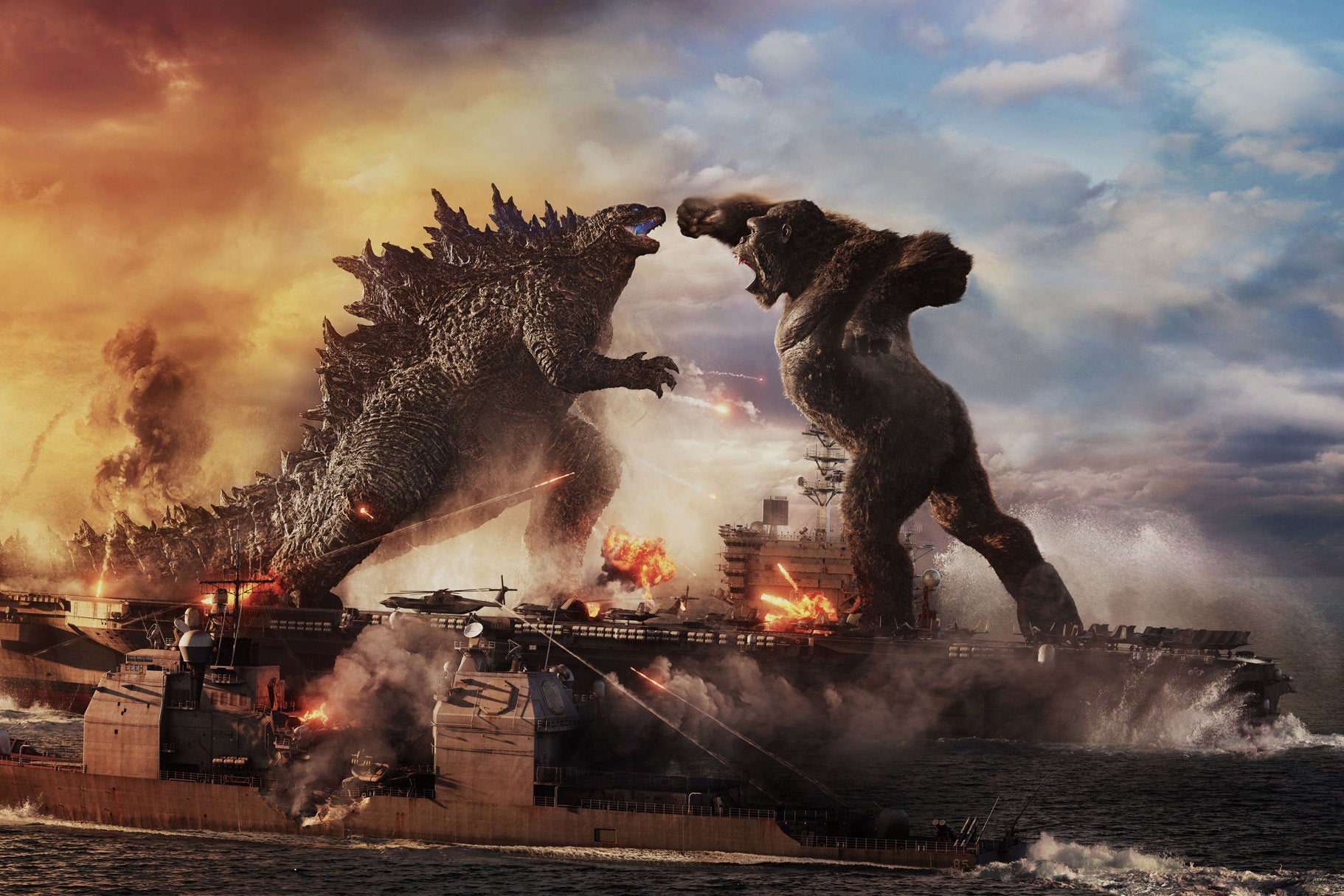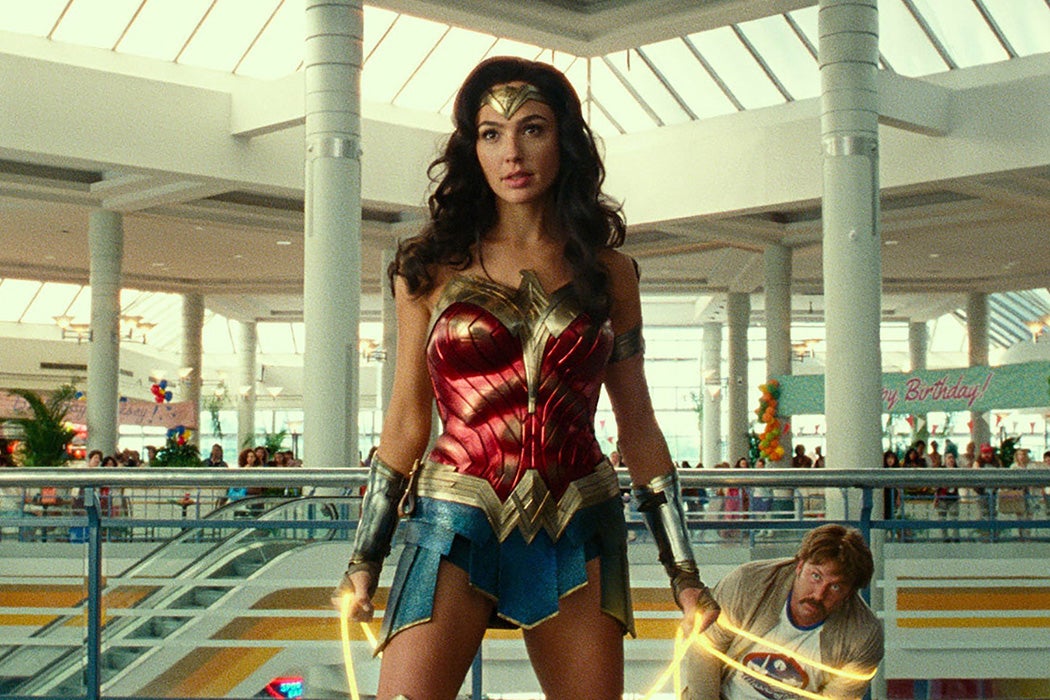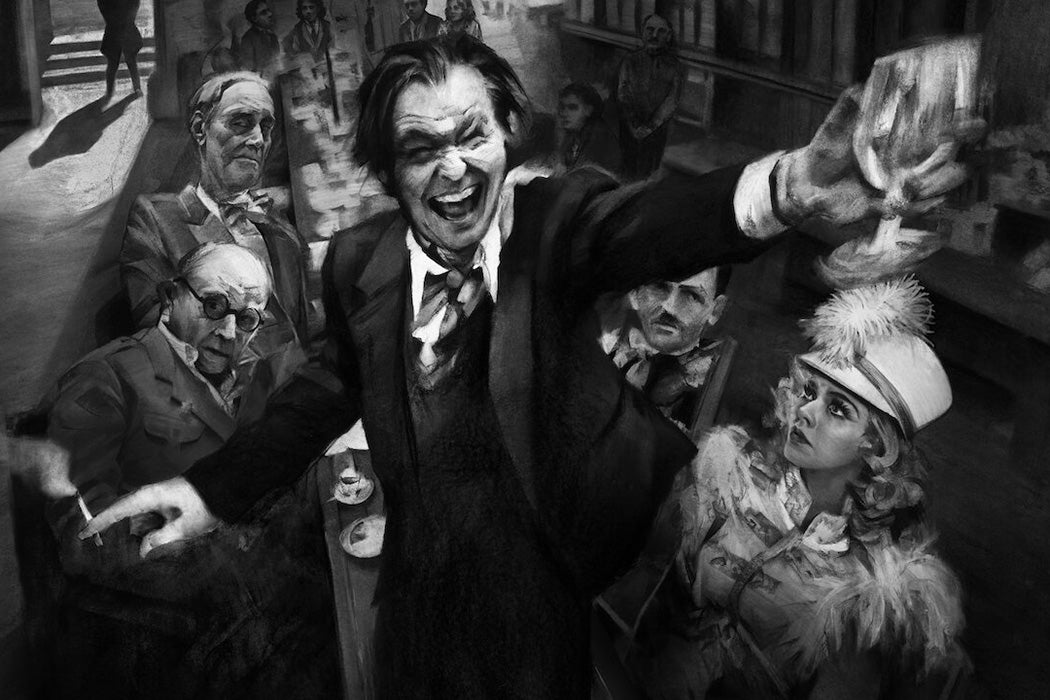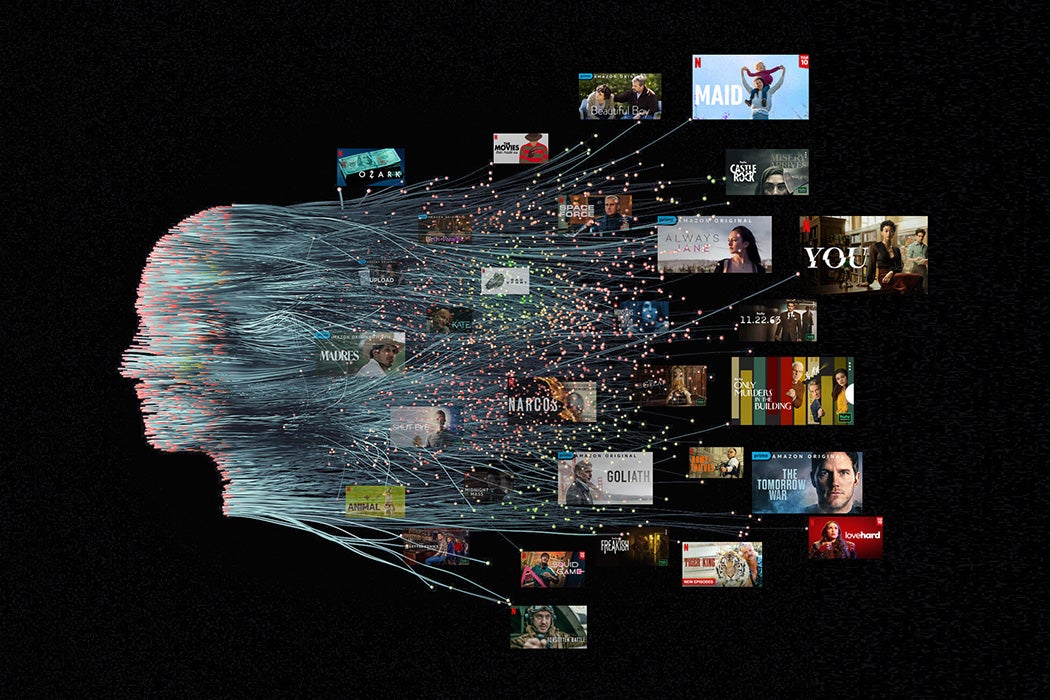The way Netflix tells it, the company’s explosion into a media monster that disrupted the entire film industry was simply a matter of supply and demand: audiences wanted it, so they delivered. “In a world where consumer choice is driving everything—how we shop, how we order groceries, how we are entertained—we’re trying to get to a place where consumers have theatrical viewing as a choice,” Scott Stuber, the head of original films at Netflix, told the New York Times in 2018. “But we also think it’s critical that, if you don’t have the means or the access or the time to go to a theater, you are still able to see movies without a long wait.”
Netflix has responded to this mandate by ramping up production to levels not seen since Hollywood’s Golden Age. In releasing upwards of 70 new movies a year, Netflix has made legacy studios look like scrappy indie outfits and encouraged competitors like HBO Max and Disney+ to not only expand their slate of originals, but to debut the latest features from their parent companies online, sometimes the same week they hit theaters, just to stay in the game. (COVID-19 also had something to do with that.)
Weekly Newsletter
In the streaming wars, audiences have access to more movies than they could possibly consume, even in a once-in-a-century pandemic that has left many homebound. Yet ironically, in this rush to give consumers more “choice,” the streamers have systematically devalued creatives, leading to a glut of mediocre movies that fade from memory the second the credits roll.
In many ways, the streamers have been rebuilding Hollywood’s old studio system. That system, which lasted roughly from the 1920s to the 1950s, was powered by vertical integration. Major studios like Paramount or Warner Bros. didn’t just own a bunch of soundstages, but also the theater chains that screened their movies, meaning they had complete control over every aspect of a movie’s creation—a straight line down from film production to distribution to exhibition. Hollywood was a “dream factory” for a reason; each screenwriter, actor, and set decorator was technically under one roof, screwing in their piece of the prototype before it slid off the conveyor belt.
This finely tuned system began to unravel in 1948 with the landmark Paramount decision at the Supreme Court. A decade-long case initiated by the Department of Justice, US v. Paramount Pictures arrived at a time when, as film professor Lea Jacobs observes, loud protests over studio practices from both independent exhibitors and local censor groups, along with a newly invigorated federal antitrust division, helped produce what contemporary legal minds would call “the Government’s greatest victory in the 60 year history of antitrust enforcement.” The Court ordered Paramount, MGM, RKO, Twentieth Century Fox, and Warner Bros.—the “Big Five” studios at the time—to divest from their theater chains, barring them from acquiring any new theaters and from distributing films without express court approval. With the bang of a gavel, Hollywood’s assembly line was effectively broken.
In recent years, conglomerations have been replicating this playbook, albeit with a modern twist. Media companies have been cannibalizing each other for decades now: Comcast has bought Universal; AT&T has acquired Warner Bros.; and Disney just gobbled up Fox. And while there’s nothing stopping these giants from buying a movie theater tomorrow—the Department of Justice successfully repealed the Paramount consent decrees in 2019, and most of these companies were not named in the original Supreme Court decision anyway—they’ve shown little interest in buying movie theaters thus far, apart from a few small sales and industry whispers. Instead, they’re using streamers as their means of film distribution and exhibition. The full potential of this system was seen last year amid the coronavirus outbreak, as studios delayed traditional releases into shuttered movie theaters and debuted the latest version of Mulan, Wonder Woman 1984, and Godzilla vs. Kong in millions of living rooms.

As this modern studio system emerges, the production numbers are increasing accordingly. During Hollywood’s Golden Age, a massive studio like MGM produced roughly 50 movies a year. Netflix has now matched and surpassed that figure, and other studios are not far behind. According to the Wall Street Journal, while Netflix produced the most movies between 2016 and early 2020 with 133, Sony was a close second with 111, with Universal trailing just behind. The sheer volume has even made waves abroad, where publicly funded companies like the BBC are pooling their resources on streaming services (in this case, BritBox) to stay competitive, a shift that entertainment critic Dennis Broe argues is decreasing the amount of local content with a more social appeal.
The parallels between the studio system and current streamers are ample, but perhaps a more useful historical analogy is not the heyday of Hollywood but the immediate aftermath of the studio system collapse. As output at traditional studios dwindled and newly empowered movie theaters clamored for more product, men like Irving Levin stepped in to fulfill a market need. According to film historian Peter Labuza, Levin was a distributor who cut his teeth on B movies and later “used independent filmmakers and stars to shield [his] corporate schemes.”
The most notable independent star in this case was actress-director Ida Lupino, whose indie production company Filmmakers needed a reliable distribution deal. Under the banner Filmmakers Releasing Organ (FRO), Levin convinced movie theaters to buy into Lupino’s movies before they were even shot, a pre-production investment made in exchange for exclusive distribution. Hungry for new movies and looking to avoid studio interference, a surprising number of theater owners signed onto these “exhibitor guarantee plans,” even though, as Labuza notes, they “increasingly resembl[ed] a Ponzi scheme.”
After Lupino left Filmmakers, however, the quality of films dipped. Levin pivoted in turn to “highly gimmicked and exploitable” movies geared toward young people. He also started buying up movies he had not produced to entice more theater owners to sign his contracts, and invited some of those owners onto an “advisory committee,” mining them for movie ideas. “As Levin and others argued, the shortage in pictures justified their behavior because it gave audiences more choices,” Labuza writes.
Swap out “advisory committee” for “algorithm” and you have the corporate strategies of today’s streamers laid bare. Labuza draws a direct line between Levin’s FRO and Amazon, which initially “appealed to consumers by producing films by auteurs like Spike Lee, James Gray, Jim Jarmusch, and Park Chan-wook… but once established, Amazon quickly shifted away from theatrical prioritization and toward its subscription service, while notably investing less in the same auteurs that brought it legitimacy.” This flickering interest in quality and prestige is also borne out in the critical and public reception of streamer originals. As the Wall Street Journal argues:
Streamers… aspire to lure subscribers with a steady flow of films and series to keep them satisfied enough to continue paying their subscription fee—which costs roughly the same as one theater ticket—month after month. The importance of how good each individual film is, both from a company and a consumer standpoint, is lowered.
Working off data from the research firm Ampere, the paper found that consumers “lost interest in Netflix films faster than those made by major studios,” and that Netflix films scored an average score of 59.1 out of 100 among viewers and 54.4 among critics, by far the lowest among its competitors. For comparison, Disney scores 70.3 out of 100 among viewers and 66 among critics; Netflix also trails Sony, Universal, Fox, Warner Brothers, and Paramount.

These scores are a natural result of streaming giants’ devaluation of creative work. Taking the old “dream factory” moniker a bit too literally, they have attempted to automate as much of the process as possible, but in doing so have often stamped the creative spark, the “dream” itself, out of the product. Critic Judy Berman argues in The Baffler, for instance, that the internet and the larger “streaming void” it perpetuates have slowly been killing the cult film, the “scruffy, desperately original, and intermittently brilliant works of transgressive art” once enjoyed communally on the midnight circuit, but now cynically engineered for social media engagement, à la Sharknado. Naturally, it’s not just the makers of would-be Rocky Horrors who are suffering. Writers more generally have lost leverage in the streaming wars.
A writer’s worth had already been depreciating as the wider industry focused on blockbuster franchises and popular IP, a movement that has seen studios like Disney, particularly on its Marvel films and TV shows, demand free rewrites or pitches and drastically reduce development budgets. UC San Diego communications professor Shawna Kidman notes that Marvel rarely develops films it does not intend to make, shrinking the traditional development slate and eliminating possible income on unproduced screenplays. Franchise filmmaking also led to the creation of movie “writers’ rooms,” wherein studios would task a group of screenwriters with developing multiple films in an extended universe in one go. Franchises have also led to the elimination of multistep deals, which actually compensate writers for drafts and revisions.
The writers who can find work now are often beholden to fandom and algorithms. As writer-director Cary Fukunaga revealed in a GQ interview, Netflix gives story notes based not on characterization or pacing but on user data, warning writers, “We know based on our data that if you do this, we will lose this many viewers.” These tweaks to the creative process smack of soulless startup nonsense, where unreliable or outright manipulated “data” matters more than actual people. But the subscribers need more content, and the streamers need more subscribers, so like Levin before them, the executives in charge insist that the ends justify their means.
Current industry trends do not just sideline writers, but all creatives. Actors also have less currency when a brand, character, or gimmick (i.e. Bird Box’s “keep on the blindfold or die” gimmick) is more important than a marquee name, and have less opportunity to earn residuals without a theatrical release. Netflix long stymied cinematographers as well: it refused to permit the ARRI Alexa, a massively popular camera, on its original films due to the company’s 4K resolution requirement. Rather than listen to the experts, the industry bowed to Netflix, as ARRI released a new model with a 4.5K sensor, nicknamed “the Netflix camera.” Creatives and critics have continued to complain about the 4K resolution requirement, which lends many Netflix films a flat, hollow look—perhaps most readily apparent in David Fincher’s awards-bait film Mank, an ode to classic film that ironically looks like a muddy watercolor of the movies to which it pays homage.

So many Netflix originals end up feeling that way, like cheap knockoffs of the real thing. In Love Wedding Repeat, the banter sounds like the muffled cries of a watchable rom-com playing two rooms away. Everyone, regardless of relationship—would-be love interest, sibling, best friend—interacts as though they’re on a first date from hell, grimacing through awkward pauses and occasionally swearing to prove they’re still human. The pieces are technically there, but something went wrong with the factory settings. Likewise, Extraction is clearly trying to emulate the stunning fight choreography of The Raid and the compelling protagonist of John Wick, but offers little more than an unexpected weapon choice (a rake) and a Hollywood Chris action figure.
It can be tempting to write this off as a Netflix problem, but the competition has shown a similar disregard for their movies and the people who watch them. Users have long grumbled that Amazon Prime Video is practically unusable, full of bugs that make streaming difficult. The platform is organized so chaotically that searching for specific movies, not browsing, is your only option. These careless UI designs reveal the low priority of this venture to the larger Amazon conglomerate, which reached the $1 trillion market cap in early 2020. Meanwhile, newer streamers like Disney+ are slavishly mining their IP for branded originals, and the latest offering, Home Sweet Home Alone, does not inspire confidence.
As film production ramps up again to pre-pandemic levels again, it’s worth asking what we’re getting out of all this unprecedented choice. Is it a stockpile of surprising, thrilling movies made by valued creative teams? Or is it mostly content, designed to be tiles on our home screen, just enough for us to renew that $15 subscription for one more month?







